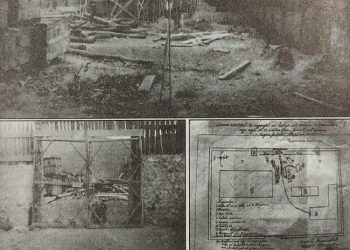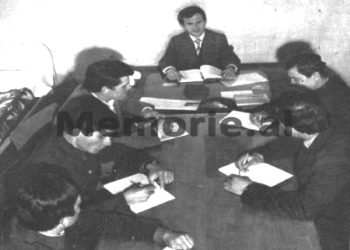From Ilirjan Gjika
Memorie.al / What made Jakov Milaj famous as an intellectual is undoubtedly his monumental book: “The Albanian Race”, the first anthropological work in Albania. When this book was published, in those days of January 1944, the author was still young, only 31 years old, although he was known as a friend of Migjeni, Petro Marko, Branko Merxhani, Andrea Varfi, Mitrush Kuteli and Vedat Kokona. In other words, he was part of the intellectual elite in Albania in the 1930s and 1940s. With a prominent creative profile, he would be the protagonist of a series of events of the time, until the communist regime forced him to remain silent for a long period of time, persecuting and displacing him as a figure of Albanian culture and science.
Jakov Milaj was born on March 30, 1912, in the “Shkoze” neighborhood of the city of Fier, in the family of Naun Milaj, a small merchant, who provided his and his family’s livelihood with honest work. Jakov’s childhood and early youth would quickly pass through difficult and turbulent times, such as: the First World War, the Congress of Lushnja, the War of Vlora, the ‘Democratic Movement’ of the years 1920-1924, etc.
Such figures as the democratic patriot, Naum Prifti, his cousin and high school teacher, or the outstanding intellectual Mirash Ivanaj, later Minister of Education, influenced the young man from Fierak with their personality. As early as high school, young Jakov was strongly involved in the cultural movement, where for a while, he will also be the chairman of the cultural association “Albanian faith “.
He applied the experience he gained in Shkodër, as a prominent social activist, years later in his hometown of Fier. Together with other students, such as; Jorgji Xoxa and Namik Resuli, Jakov Milaj would be the initiator of the organization of the “Apolonia” Sports Society, where he would also be elected its chairman for several years. There he worked for the organization of sports activities, together with Mustafa Kacaçin, whom he had been friends with since the gymnasium of Shkodra.
After finishing high school, Milaj served for some time as a teacher and as the secretary of the Municipality of Kolonje. At this time, he began to write and deal with journalism, in a number of newspapers and magazines of the Albanian press, such as: “Arbëria”, ” The Albanian effort “, “Newspaper of Tirana “, “Besa”, “Vatra”, etc. .
In 1935, Jakov Milaj took part in the Fier Uprising, where after its failure he was arrested and sentenced by a special court to life imprisonment.
Taking advantage of the amnesty of a few months later, he will be released and will then leave for Italy, where he continued his studies at the University of Turin, for Veterinary Medicine. In Turin, Jakov Milaj would be one of those who shared the last moments with Migjeni, who had gone to be cured at the sanatorium of Tore Peliçe. At the last meeting, Millosh Gjergj Nikolla entrusted him with the manuscript of the poem “Free verses “, which Milaj saved and brought to Albania, handing it over to his sister Olga.
Upon returning to Albania, he started working as a veterinarian, first on the farm of Xhafzotaj and then in the sub-prefecture of Fier. During the Italian occupation, Jakov Milaj served for a short time as the Minister of Agriculture and Forestry, in the government headed by Malik Bushati, during 1943.
“As a minister, I requested that the forest areas be separated from the Italian administration and that the Italian forest police are replaced by the Albanian police. My request was ignored by Bushati and Pariani, so I resigned. That Government was a shame”, Jakov Milaj wrote years later, in his memoirs.
During the period of the German occupation, Milaj remained unengaged and in January 1944 he published the book “Albanian race”. “Although Tirana was perverted in that period, surprisingly the intellectual circles received the book well”, he continues again in his memoirs.
Meanwhile, in 1945, under the charge of being a collaborator, Milaj was sentenced by the Special Court to 15 years in prison. After spending 6 years in labor camps, such as in Kamëz and Xhafzotaj, he was released by taking advantage of amnesties, but was subjected to deportation, first in Llakatund in Vlora and then in the village of Shtyllas in Fier.
Finally, in 1956, he was allowed to settle in Fier, together with his family, and this same year, he started working at the “Liberation” Agricultural Enterprise, where he worked until he retired.
“I met the doctor for the first time at the ‘Liberation’ farm as a dedicated, intellectual man, who was not ashamed to give his contribution among the cattle”, he emphasized in his statement, held in the scientific session “Ethnogenesis of Albanians in the optics of the work of Jakov Milaj”, Prof. Bedri Dedja, in 1995.
In addition to his daily work as a veterinarian, until he retired, Jakov Milaj also dealt with professional literature, where he published eight books on animal husbandry, which were a valuable help in supplementing knowledge in this field. He spent the last years of his life in Fier, where he welcomed the democratic changes of the 1990s with special pleasure. He died on January 2, 1997 at the age of 85.
A deep connoisseur of many scientific disciplines, Jakov Milaj was considered alive as a “moving encyclopedia”. There are dozens of his studies, published in the form of books, brochures, articles in magazines and newspapers. He was presented to the public and intellectual circles, as; historian, publicist, essayist, linguist, ethnologist, zootechnician, veterinarian and anthropologist.
Milaj started his intellectual activity in the field of journalism, where he started writing as early as school. The first articles were from history and translations obtained from the foreign press. We can mention articles on; Marconi, Bulgarian Literature, Qemal Ataturk, Beethoven’s Life, which belong to the field of Albanian pronunciation, while from historical journalism, we can mention articles published in the newspapers of the time, such as; “Hymn of the Flag”, “Dom Ndre Mjeda”, “Lady Marigo and the national flag”, “Flag Day”, “Vlora on November 28”, “Characteristics of the Illyrians”, “Kostandin Kristoforidhi”, etc.
During the first half of the 1930s, Jakov Milaj worked as an editor in the newspapers: “Vatra”, which was run by Timo Dilo, and “Përpjekja Shqiptare”, by Branko Merxhani. It was here that he met (as he describes in his memoirs), on a summer day in 1936, in one of Tirana’s restaurants, what would become one of his closest friends, Migjen.
Meanwhile, in addition to journalism, Jakov Milaj had a special passion for history. He first started his historical studies by collecting field material, to continue with more extensive research and synthesis works. Such works as: “Our ancient Fier”, “Raising the flag in Fier”, “The old church of Fier”, “Vrionas”, “Fieri in the war of Vlora”, “Naun Prifti”, etc., constitute today one of the main sources for the history of Fier and its region. Also, Jakov Milaj’s memoirs about the Fier Uprising of 1935, where he was an active participant, are one of the best works in this field.
Thus, Jakov Milaj is the first to formulate the thesis that the first station of the southern branch of Egnatia is Fieri, whose name in antiquity was ‘Ad Novas’. Just as intriguing is the other thesis, which he puts into the study of the church of Saint George, where, among other things, he says that: “In the 16th century, to commemorate the name of George Kastrioti, a large part of the churches of Albania changed their names from the previous names in Saint George, but to keep the dream of freedom alive”.
In addition to intellectual activity, Milaj also worked with dedication in his profession, becoming one of the personalities of this field in our country. After graduating from the faculty on July 17, 1939, he started working as a laboratory chief in Durrës, and then in Korçë. In November 1939, we find him in Fier, founding the Veterinary Service of this sub-prefecture.
As a veterinary inspector, he worked diligently, putting his deep knowledge at the service of this field. After the Liberation, he continued to work again in the profession, first in Kamëz, Xhafzotaj, Llakatund in Vlora and then in the Agricultural Enterprise “Liberation” in Fier, where he remained as chief veterinarian until he retired.
In addition to field work, countless advices and consultations, Jakov Milaj provided an extraordinary help in a number of numerous publications of a practical and scientific nature. In 1960, his book “How to Raise Fat Calves” was published, which was followed by other books, which were published by the House of Agricultural Propaganda. Such were “The ABC of the Milker” in 1973, “Diseases of Pigs” in 1973 and “Notes on Cow Fertility” published in 1982.
Jakov Milaj was also the author of a series of textbooks for the students of the Veterinary department at the Higher Agricultural Institute. We can mention: “Buffalo breeding”, “Calve disease in growing”, “Health protection of agricultural animals”, etc. Also as an author and co-author, he published a number of scientific articles, in the years 1965-1981, both in the “Bulletin of Agricultural Sciences” and the newspaper “Drapë dë Çekan”, published in Fier.
But the work that made Jakov Milaj famous is the “Albanian Race”, which is the first anthropological monograph, in which the origin of the Albanian people is scientifically proven.
“Every true science has its precursors. It is true that anthropology, as a part of the Albanian sciences, entered a good path in these last decades, but it has as its pioneer, Dr. Jakov Milajn”, says Prof. Dr. Aleksandër Dhima (Ethnogenesis of Albanians in the light of the work “Albanian Race”, by Dr. Jakov Milaj, Scientific Session, Fier, 24. 04. 1995).
Regarding the messages that the “Albanian Race” brings, the patriotic tones and the pure national spirit, the author himself writes that: “Anthropology was not the main purpose of the book. At that time in Albania, everything was talked about, except for the national feeling, there was little talk”! While for this book, Prof. Anton Çeta, declared to the author 50 years after its publication that: “In Kosovo, we have kept the “Albanian Race” as the Gospel”.
“The Albanian race, which for thousands of years has preserved its blood so pure, its plastic beauty and rare spiritual virtues, must be beautified and improved much more now that the harsh waves of the dark times have passed and are waiting for it days whiter”, Milaj concludes his study (Jakov Milaj, ‘Raca Shqiptare’, Ismail Mal Osmani, Tirana, 1944, p. 151).
After the first publication in January 1944, the book “Albanian Race” was reprinted three more times. First in Pristina by “Valton” in 1994, then in Tirana, in 1995, by “Eurorilindja”, as well as in 2005, by “Uegen” Publishing House. /Memorie.al
















